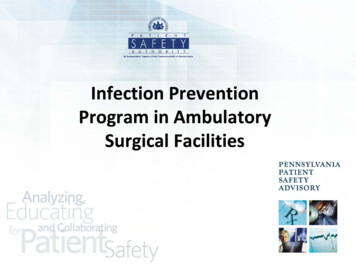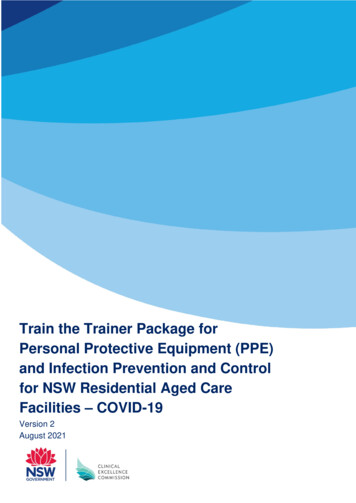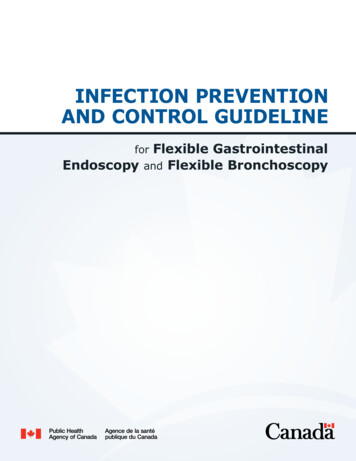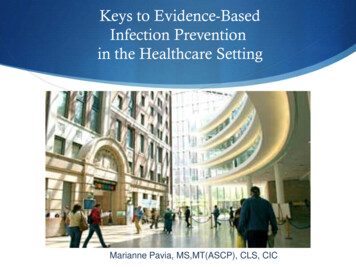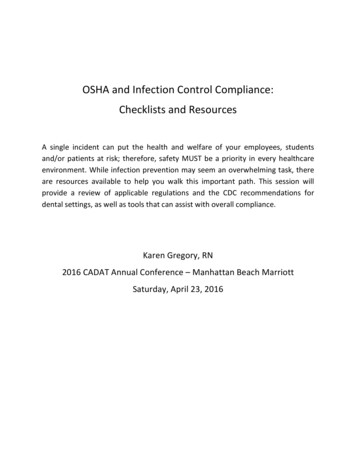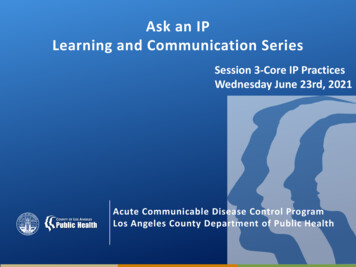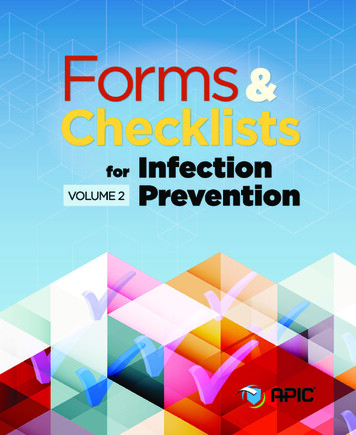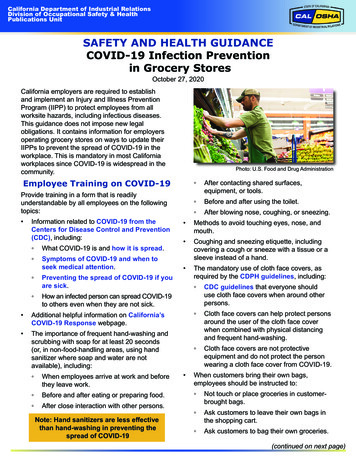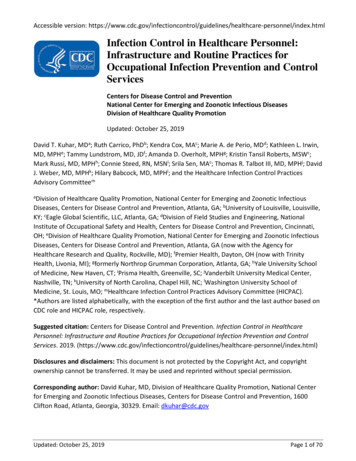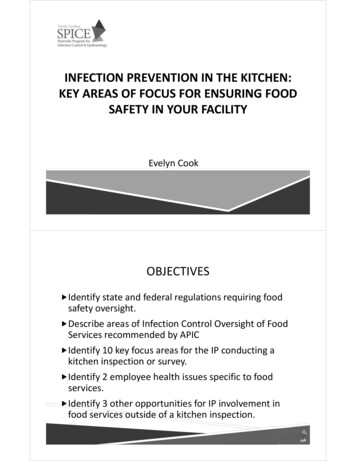
Transcription
//ECDC TECHNICAL REPORTInfection prevention and control for COVID-19in healthcare settings - first update12 March 2020Scope of this documentThis document aims to provide guidance to EU/EEA healthcare facilities and healthcare providers on infectionprevention and control measures during the management of suspected and confirmed cases of COVID-19 infection inhealthcare settings, including long-term care facilities (LTCF). It also offers guidance on the management ofspecimens in laboratories in the EU/EEA.This is an update of the ECDC guidance from February 2020 ‘Infection prevention and control for the care of patientswith 2019-nCoV in healthcare settings’ [1]. This update addresses the possible limited supply of personal protectiveequipment (PPE), hand hygiene materials, and environmental hygiene materials for healthcare facilitiesin the EU/EEA countries and the United Kingdom.Target audienceHospital administrators, LTCF administrators and healthcare practitioners in EU/EEA countries and the UnitedKingdom.BackgroundOn 31 December 2019, a cluster of pneumonia cases of unknown aetiology was reported in Wuhan, HubeiProvince, China. On 9 January 2020, China CDC reported a novel coronavirus in the SARS-CoV phylogenetic cladeas the causative agent of this outbreak. The associated disease is now referred to as novel coronavirus disease2019 (COVID-19). The clinical presentation of COVID-19 ranges from asymptomatic to severe pneumonia withacute respiratory distress syndrome, septic shock and multi-organ failure, which may result in death. Analyses ofcases suggest that COVID-19 infection causes mild disease (i.e. non-pneumonia or mild pneumonia) in about 80% ofcases. Most cases recover, 14 % have more severe disease, and 6% experience critical illness requiringspecialist medical care, including mechanical ventilation [2]. The majority of the most severe illnesses and deathshave occurred among the elderly and those with other chronic underlying conditions. Additionally, older personsare at higher risk of adverse outcomes of COVID-19, including the requirement for specialised hospital care and afatal outcome [3]. Residents in long-term care facilities (LTCF) are commonly more vulnerable to infections thanthe general population [10]. As COVID-19 is caused by a newly identified virus, there are no therapeutics or vaccinesavailable, and there is presumed to be no pre-existing immunity in the population [3].In most instances, coronaviruses are believed to be transmitted through large respiratory droplets from person toperson, through inhalation or deposition on mucosal surfaces. Other routes implicated in transmission ofcoronaviruses include contact with contaminated fomites and inhalation of aerosols produced during aerosolgenerating procedures. SARS-CoV-2 virus has been detected in respiratory, faecal and blood specimens [4]. Thehighest risk of healthcare-associated transmission occurs in the absence of standard precautions, when basic infectionprevention and control measures for respiratory infections are not in place, and when handling patientsSuggested citation: European Centre for Disease Prevention and Control. Infection prevention and control for COVID-19 inhealthcare settings – March 2020. ECDC: Stockholm; 2020. European Centre for Disease Prevention and Control, Stockholm, 2020
ECDC TECHNICAL REPORTInfection prevention and control for COVID-19 in healthcare settingswhose COVID-19 infection is yet to be confirmed. Although airborne transmission is not considered the principaltransmission route, we recommend a cautious approach because of possible transmission through aerosols [5,6].More disease background information is available online (ECDC [7], WHO [8]) and in ECDC’s Rapid RiskAssessment [3].Healthcare settingsThe following sections provide a high-level outline of technical measures and resources for reducing the risk oftransmission of COVID-19 in healthcare settings (including LTCFs) and laboratories in the EU/EEA. It draws oninterim advice produced by WHO and national agencies, and also expert opinion [9,11,12,15,29]General infection prevention and control measuresPeople feeling ill with respiratory symptoms should be encouraged to contact healthcare services to seek medicaladvice by telephone or telemedicine/online.Triage, initial contact and assessment (primary andemergency care) Emergency services and primary care staff, including physicians, nursing and administrative staff with patientcontact, should be aware of: a) the current COVID-19 epidemiologic situation in their country and globally,b) known risk factors for infections; c) clinical symptoms and signs of COVID-19; d) recommended infectionprevention and control measures, including those in this document; e) procedures for reporting and transfer ofpersons under investigation and of probable/confirmed casesAssess the onsite availability of appropriate personal protective equipment (PPE) for all personnel at the pointof-care to apply standard, contact and droplet precautionsTriage by telephone or telemedicine/online, if possible, to reduce the number of people with symptoms ofCOVID-19 that have contact with healthcarePerform a point-of-care risk assessment to assess the likelihood of COVID-19 infection, including the clinicalpresentation of the patient and a review of clinical, epidemiological and travel history. This should aim toachieve a rapid evaluation of the risk of infectiousness, based on signs, symptoms and the procedures likely toresult in infectious respiratory droplets and aerosols. The assessment should be based on the latest casedefinitions [13]Be aware of requirements for testing and the case definitions [13] for reporting of casesConsider, on a case-by-case risk assessment, the use of PPE for the different procedures to be performed.Based on the current knowledge on the transmission of COVID-19, in which respiratory droplets seem to playa major role (although airborne transmission cannot be ruled out at this stage), and taking into considerationthe possible shortage of PPE in healthcare settings due to the increasing number of COVID-19 patients [14],the suggested set of PPE for droplet, contact and airborne transmission (gloves, goggles, gown and FFP2/FFP3respirator) can be adapted for the clinical assessment of suspected COVID-19 cases as below: Healthcare workers performing the first assessment without direct contact; the patient should wear asurgical mask and keep a distance of at least 1 metre. If possible, a physical barrier such as glass or aplastic teller window can be used to avoid direct contact and keep the distance; in such case no PPE isnecessary [15]If available, provide a surgical mask for patients with respiratory symptoms (e.g. cough)Healthcare workers performing aerosol-generating procedures (AGP), such as swabbing [16], shouldwear the suggested PPE set for droplet, contact and airborne transmission (gloves, goggles, gown andFFP2/FFP3 respirator) [17]If there is a shortage of FFP2/FFP3 respirators, healthcare workers performing procedures in directcontact with a suspected or confirmed case (but not at risk for generating aerosol) can consider wearinga mask with the highest available filter level, such as a surgical mask, in addition to gloves, goggles andgown.In order to maximize the use of PPE if there is an insufficient access to stocks of PPE materials, staff should beassigned to carry out procedures, or a procedure, in designated areas. For example, assign staff to swabbingprocedures in a dedicated swabbing area. While swabbing patients, healthcare personnel can use the samerespirator for several patients for a maximum of 4 hours without having to remove the respirator, as long as itis not damaged or soiled, unless the manufacturer explicitly advises against this [15].Be aware that suspected cases of COVID-19 should be isolated, or at least separated, from other patients.They should be instructed to wear a surgical mask and practice appropriate hand hygiene. If possible,dedicated toilet facilities should be made available. Non-essential contacts between suspected cases and otherpersons should be minimised2
ECDC TECHNICAL REPORT Infection prevention and control for COVID-19 in healthcare settingsContact a designated 24/7 response service, such as local public health authorities to report the case, arrangediagnostic testing and, if the initial assessment indicates it is appropriate (e.g. symptoms and signs thatincrease risks of transmission), safe transfer to a designated acute care unit for diagnostic evaluation.Patient transport Ensure the availability of a preparedness plan for ambulance transfers of suspected or confirmed COVID-19cases, addressing the temporal and geographic coverage of adequately trained staff and equipment.For ambulance transfers of suspected or confirmed COVID-19 cases, ensure that healthcare staff wear PPE,the decontaminate the ambulance after the transfer of the patient, and practice safe waste management asper appropriate procedure. For PPE use for healthcare workers travelling with the patient, please refer to the section above. It is thesame as during the first contact with a patient (surgical mask in addition to gloves, goggles and gown) ifthere is a shortage of respirators and if there is a low risk of aerosol generation. If available, provide a surgical mask for patients with respiratory symptoms (e.g. cough). Persons sitting in the front of the ambulance, including the driver, will not be in contact with the patient(i.e. maintaining a distance of at least 1 meter). If there is no physical separation between the front andthe back of the ambulance, a surgical mask should be considered [15].HospitalsAdministrative measures Designate a staff member to be the lead for infection prevention and control and preparedness for COVID-19.This person will be responsible for staff training. Strongly consider initiating training sessions on infectionprevention and control (IPC) for all staff, not only healthcare staff.If possible, also provide training to those who may called in at a later point in time to provide surge capacity,for example agency staff, student doctors/nurses, and retired health professionals.Ensure that all people, including patients and visitors, in the healthcare facility are aware of hand andrespiratory hygiene, including cough etiquette.Constitute a hospital ‘COVID-19 preparedness and response committee’ (or use an existing emergencymanagement committee) with representatives from all clinical and support departments as well as senioradministrators. Participate in a local healthcare coalition; this should include neighbouring hospitals, localpublic health agencies, and emergency management. Members of multi-hospital health systems shouldintegrate system-wide planning and local planning with other local hospitals [18].To ensure preparedness for a surge in critically ill patients, identify rooms to care for these patients. Forexample, identify which non-urgent outpatient visits can be re-scheduled or cancelled, and which electiveurgent inpatient diagnostic and surgical procedures can be moved to the outpatient setting, re-scheduled orcancelled [19,20].Identify and designate additional separate units that can be used for diagnostic evaluation and treatment ofCOVID-19 patients.Plan for surge capacity, estimate the needs for patient beds, respiratory support, PPE, staff, diagnostics; alsoinclude laboratory capacity and therapeutics in your estimates.Ensure access to timely virological investigations in accordance with the algorithm for laboratory diagnosis ofCOVID-19 (Laboratory testing for coronavirus disease 2019 (COVID-19) in suspected human cases [21]).Be aware of the minimum requirements for designated units for the management of confirmed COVID-19patients: the availability of isolation rooms with a dedicated bathroom, staff adequately trained in the safediagnostic evaluation and management of COVID-19 patients, availability of appropriate PPE and hand hygieneproducts, adequate laboratory support, appropriate cleaning, and appropriate waste management procedures(see below under ‘Environmental cleaning and waste management’).Negative pressure isolation rooms are strongly recommended for aerosol-generating procedures (AGP) (seealso under ‘Patient management’).Patient management Confirmed cases requiring admission should be admitted to an isolation room with a dedicated bathroom. Theplacement in airborne-precaution single rooms with negative pressure and anteroom, if available, isencouraged, especially for patients requiring AGPs.Hospitals should consider cohorting confirmed COVID-19 patients, as if there is a large increase in the numberof COVID-19 cases in a hospital, there may not be enough isolation rooms or airborne-precaution single roomswith negative pressures and ante-rooms. Additionally, this provides the opportunity to conserve the use ofPPE.If there are high numbers of COVID-19 cases, designating entire sections of a facility solely to the treatment ofthe COVID-19 cases could reduce the potential transmission of COVID-19 to non-cases.3
ECDC TECHNICAL REPORT Infection prevention and control for COVID-19 in healthcare settingsHealthcare workers in contact with a confirmed case, or a suspected case of COVID-19, should wear PPE forcontact, droplet and airborne transmission of pathogens: FFP2 or FFP3 respirator tested for fitting, eyeprotection (i.e. goggles or face shield), long-sleeved water-resistant gown and gloves [17].In order to maximize the use of PPE in the event of shortages, it is acceptable for staff to wear the samerespirator while caring for multiple patients with the same diagnosis without removing the respirator if therespirator is not damaged, soiled or contaminated. This reduces consumption of PPE. The use of the samerespirator while treating multiple patients should be considered; the maximum time a respirator can be worn is4 hours, as long as it is not removed between patients or contraindicated by the manufacturer [15].Face masks (surgical masks) mainly protect from exhaled droplets. Their use is recommended if there is ashortage of respirators and on a case-by-case assessment. Surgical masks do not require fit testing [17].Aerosol-generating procedures (AGP) include, for example, tracheal intubation, bronchial suctioning,bronchoscopy, and sputum induction. These procedures have been linked to an increased risk of transmissionof coronaviruses and require protection measures [10]. If there is a shortage of respirators, it is recommendedthat they are primarily used for AGP. AGP should be performed in a negative pressure isolation room. Thenumber of persons in the room should be limited to a minimum during such procedures; all persons presentshould wear: a well-fitted FFP3 respirator, eye protection, long-sleeved impermeable protective gowns, andgloves [22]. Swabbing can be considered to be an AGP [16].Healthcare workers should strictly follow the procedures for the wearing (donning) and the safe removal(doffing) of PPE in correct sequence [17]. Active assistance during donning and doffing is a valid option forminimising the risk of accidental contamination.Hand hygiene should be performed immediately after removing PPE.It is essential to ensure that staff assigned to treat COVID-19 patients are trained in the proper use of PPE.Quality assurance should be promoted through appropriate systems before assigning staff to COVID-19 patientcare; for example, hospitals could require documented participation in a training course to ensure a staffmember’s competency in the correct use of PPE.Staff providing care to COVID-19 cases need to be actively followed-up for development of symptoms andprovided with occupational health support. Hospitals should maintain a record of all staff providing care forconfirmed COVID-19 cases. These staff, and staff who have been exposed to cases before the implementationof infection cont
Emergency services and primary care staff, including physicians, nursing and administrative staff with patient contact, should be aware of: a) the current COVID-19 epidemiologic situation in their country and globally, b) known risk factors for infections; c) clinical symptoms and signs of COVID-19; d) recommended infection
